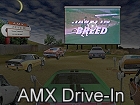Site Tools & Extras
Quick Links
American Motors eXperimental
September, 1967 Motor Trend AMX
What Hath Rambler Wrought?
Creativity isn't always a blinding flash of inspiration. Sometimes it's the end result of an evolutionary process that begins with examining the past, present and future, recognizing trends, then taking an impudent step, and, finally, letting the idea simmer through an incubation period to gather enough discipline so it can be harnessed for use. Like American Motors' Javelin and AMX projects, for instance.
AMC deserves kudos for their candid reappraisal, "We were being used as a point of reference for whatever was automotive old hat." So, in January, 1966, they tossed out a brazen feeler in the form of Project AMX, a 2-door, 2-passenger, GT-type hardtop . . and they learned fast. A galvanic reaction to the AMX effected a deluge of letters and strange, excited voices never before heard, that prodded the company into liberating itself from its prosaic past.
"The AMX, itself, plus the knowledge of what the competition was doing, convinced management that we could do it - that we could produce a well designed personal sports-type car that would sell in volume."

It was the last day of darkness, and a radical, welcome departure from previous philosophies. Responding to the stimulant, AMC decided to go all the way and cover each market of America's revitalized spirit. The world was swinging, young and old, and cars had become obvious participants.
With a one-two punch, American Motors is ready for extremes, as well as for compromises, in 1968. The AMX will satisfy the bold fringe of sporty sophisticates who only need two seats, yet stay well within the boundaries of practicality. And wishful thinkers with other considerations - like families won't be neglected. They can choose the 4-seat, long-hood, short-deck, sporty-car Javelin.
Breaking the shackles of conservatism was a difficult task, and pole positions garnered by the Big 3 in the pony car field added a discouraging element before AM initiated a new trend. But, contaminated as it was with compromise, the Tarpon of 1964 was AM's stimulant, and according to Dick Teague, vice president of automotive design, it was the Javelin's great-grandfather. Officially termed a "styling study," the Tarpon was designed as a small (180 inches overall), low-silhouette, 4-place, bucket-seat, fastback personal car.
Far from sensational, it nevertheless received a favorable reaction, and at least enabled Teague and his staff to proceed further in the specialty car field.
Charged with enthusiasm, AM was hit with the news that Ford's Mustang was unveiled, and it promised to sweep the market of exactly that person for whom the Tarpon was designed, and then some. So, the Marlin was produced as an offshoot of the Tarpon, but it was a much larger, 6-place, family-oriented version with limited appeal that didn't quite penetrate to the core of the sporty set.
By necessity, it hit them.......... "we became aware of the image that had slowly but solidly settled down on us, that of a company that turned out nice, dependable and economical cars suitable for conservative adults and families."
More and more, they became convinced that they ought to do one for the kids - a car that would capture the younger generation's imagination and down payment money. The company's short money position, however, was a major roadblock until the Society of Automotive Engineers' show in January, 1966, when the AMX was revealed for the first time.
Behind the AMX lay the crumpled prototypes of experiments, some of them admittedly described as "compromise exercises" that represented attempts to incorporate existing chassis components and certain sheetmetal parts into various design versions of a personal/specialty car. They were actually efforts to cut tooling costs, but one by one, they were discarded until it was finally realized that an all-new car was necessary.
From the drawing board through clay and several design changes - a period of about 18 months - was wrought the final Javelin prototype in April, 1966. Management was convinced, and AM took the plunge in limited production.

The decision was a justifiable one, which was supported by Project IV- a display of four experimental cars in major cities. Among these cars was the AMX II, a near-prototype of the future Javelin and a modified version of the first AMX. Reaction of the VIP groups invited to Project IV's special showings confirmed for AM's decision-makers that there was room for their new entry-to-be in the sporty-car field.
At one point in the Javelin's development, automotive rumor mills had the car featuring a frameless, fiberglass body. And, in fact, the Javelin's creative team had actually considered this revolutionary step (revolutionary for U.S. production cars) at one point, and Dow Smith, Inc., an outfit specializing in automotive fiberglass components, actually turned out three prototype bodies. Several factors influenced AM's leadership to drop the fiberglass issue in favor of the standard steel body, not the least of which was the malignancy of the safety brouhaha. The structural integrity of such a body simply couldn't be determined to be reliable enough.
Electing to go with steel instead of fiberglass, however, caused some revamping in the original design concept for the Javelin as seen in the AMX II. The entire body was shortened slightly, and minor changes were made in the hood, grille, roof line and rear fender, "in spite of this," states Teague, "we managed to keep at least 90 % of AMX II's original design characteristics in the 4-place Javelin."
Some of the known features of the production Javelin include a split grille, ventless side windows, an extremely fast windshield, and bumpers integrated with the fender contours. The basic engine is expected to be AM's 232 cu.in. 6, with 290 and 343 cu.in. V-8s available as options.
Probably one of the sincerest tributes to the Javelin's styling comes from its potentially harshest critic, Teague himself: "It's the only car that we haven't wanted to change something on after seeing it outside our studios", it's a radical departure from the company's traditional stick-to-business philosophy of automaking. Even so, the sleek, 109-inch-wheelbase Javelin and its jaunty, 2-seater companion, the AMX, are in tune with the fastest-growing segments of the automotive market, and the end products of a long-term investigation and tests of consumer reaction to various AM experimental and/or "idea" cars.
Mid-September will unveil the Javelin, and the AMX comes in early 1968. This will be the real test, whether they can capture 4% of the market or sell 45,000 Javelins next year. If they can, it will place the company solidly in the success column and more than justify the heavy tooling costs associated with producing completely new automobiles. If not, that's it, baby. However, there's now a real excitement at American Motors, and when this is combined with two completely new cars - one that even promises to be unique - and the knowledge that Yankee individuality is continually seeking something like this, it leaves many potential customers in welcome anticipation of a curtain lifting. /MT
For Motor Trend subscription information please visit MotorTrend.com







